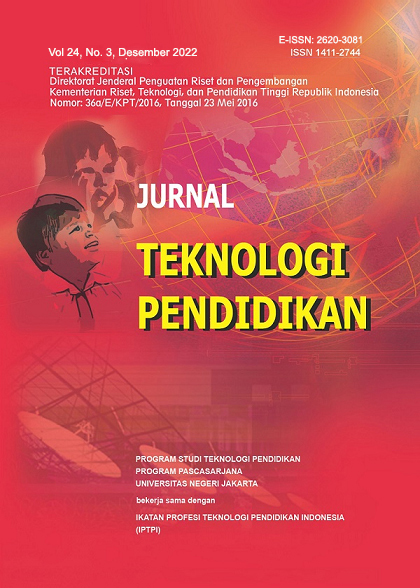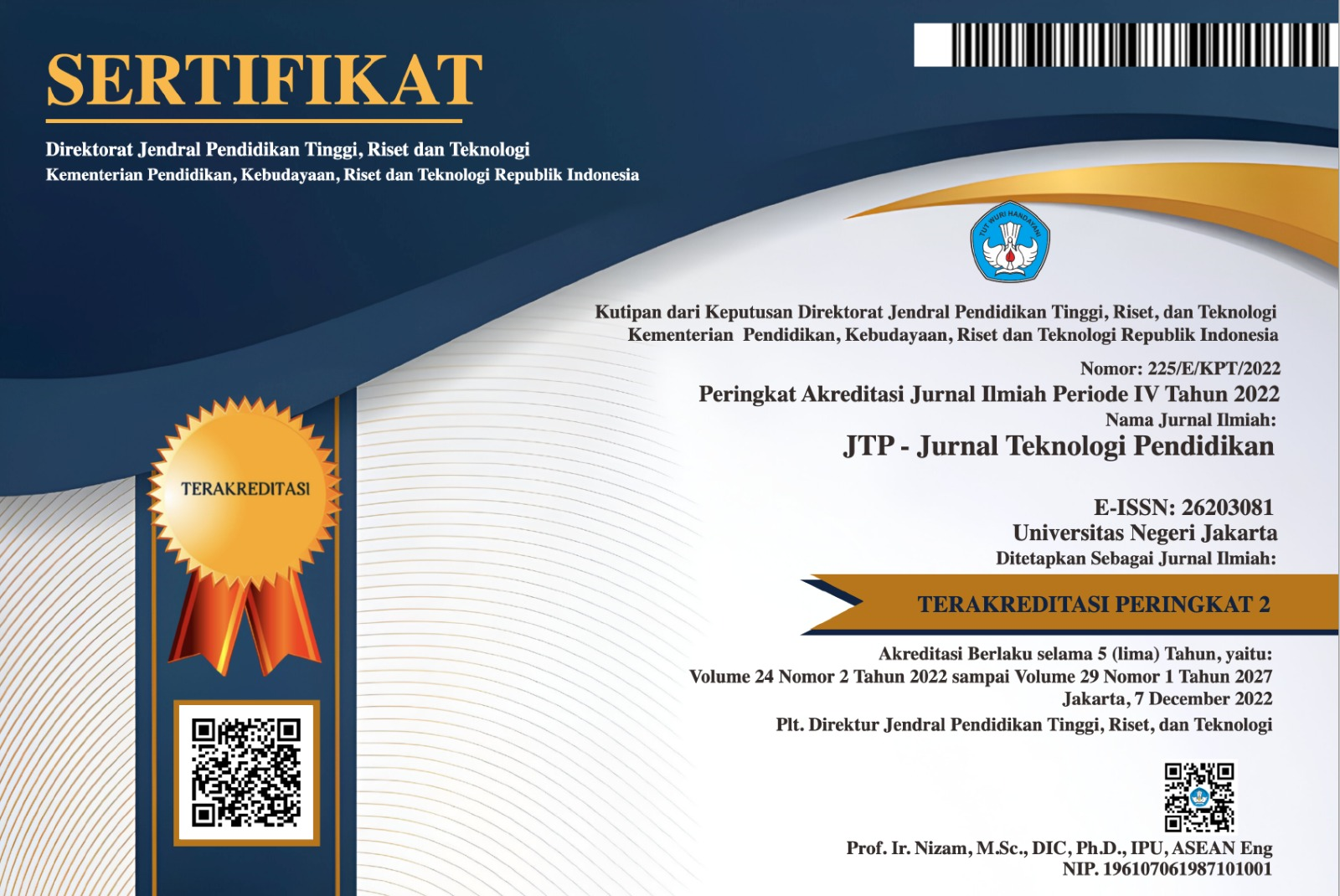Trainer Effectiveness in Basic Electrical and Electronic Practices in Vocational High Schools
DOI:
https://doi.org/10.21009/jtp.v24i3.33595Keywords:
Audio-Video, Basic Electronics Practicum Trainer, Vocational High SchoolAbstract
Basic Electricity and Electronics is one of the subjects in VHS. This subject teaches theory and practice. Practical subject matter includes: how to measure the components of resistors, capacitors, coils, transistors and other components. This study aims to determine the effectiveness of practical trainers that have been developed for basic electricity and electronics subjects that have been developed and designed as practical learning media. The method used in this study is research and development (R n D), using the Hannafin and Peck model. The feasibility of practice trainers is based on the results of expert assessments, namely (1) assessment by material experts with a percentage gain of 92.50%, (2) assessment by media experts with an acquisition percentage of 82.60%, (3) assessment of student use obtains a percentage of 86.89 %. from the results of the assessment of the experts and students, it can be concluded that the basic electronics practice trainer is said to meet the requirements and is suitable for use as a learning medium for Basic Electricity and Electronics Class X for the Department of Audio-Video Engineering at Vocational High Schools. For the effectiveness of the trainers that have been developed it is done by comparing the results of the initial test with the results which result in an increase in learning outcomes by an average of 42.98%, so it is concluded that there is an increase in learning outcomes. To test the effectiveness obtained tcount = 98.2 and ttable = 2.056, because tcount> ttable, it can be said that this trainer is effective for use in practice. A gain value of 0.8 is in the range > 0.7, this means an increase in basic electrical and electronics practical skills before and after using a basic electrical and electronics practicum trainer with a high category.
References
Gagné, R. M. (1977). The conditions of learning. (3rd ed.). Holt, Rinehart, and Winston.
Gagné, Robert Mills, Briggs, Leslie J; Wager, Walter W., (1992). Principles of instructional design. Harcourt Brace Jovanovich College Publishers.
Gall, Meredith D, Gall, J. P., & Borg, W. R. (2007). Education research. (Eighth), Pearson.
Hamid. MA. Aribowo. D. Desmira. (2017). Development of learning trainers of basic electronics-based problem-solving in vocational secondary school. Jurnal Pendidikan Vokasi,7(2), 149-157
Hannafin, M. J., & Peck, K. L. (1988). The Design, Development, and Evaluation of Instructional software (first). Macmillan.
Robert Heinich, Michael Molenda, Sharon E. Smaldino, J. D. R. (2002). Instructional Media and Technologies for Learning. (R. Heinich (Ed.) California.
Huda. S, Buditjahjanto. IGP. A, Yundra. E. (2019). Robotic learning media development for d3 students of information management unesa. Advances in Social Science, Education, and Humanities Research. Atlantis Press SARL, 379
Isrok’atun, Hanafiah Nurdinah,Sujana Atep. (2018). Melatih kemampuan problem posing: melalui situation-based learning bagi siswa sekolah dasar. Bandung: UPI Sumedang press.
Ningtyas. RK & Jati. H. (2018). Project-based electronic training development as a supporting learning media for basic programming learning. Journal of Educational Science and Technology, 4(3), 221-227. https://dx.doi.org/10.26858/est.v1i1.6999
Prasasti. FD, Situmorang. R, Kusumawardani. D. (2018). Development of integrated audiovisual training for learning animation principles at multimedia vocational school. International Journal Of Education, Information Technology, and Others, 1(2), 2654-2528.
Rahayu. I and Sukardi. (2020). A needs analysis for the development of e-trainees project-based learning. Jurnal Pendidikan Teknologi Kejuruan, Special Issue: International Conference Technology and Vocational Education and Training 3(1), 2621-1548.
Rahayu. I, and Sukardi. (2020). The development of e-trainees project-based learning for students of computer and basic networks at vocational school. Journal of Education Technology. 4, 398-403
Rahmi.U, Syahrul Ramadhan. S, Asri. Y. (2019). Development of electronic training hikayat text based on project-based learning (pjbl) class x students of high schools. Advances in Social Science, Education and Humanities Research, Atlantis Press SARL , 463
Reiser, A. Robertand and Walter Dick. (1996). Instructional Planning. 2nd Ed., USA: Allyn and Bacon.
Richey, C Rita & Klein D James. (2007). Design Development and Research. New Jersey: Lawrence Elrbum Associates.
Russel, Heininch & Molenda. (1986). Instructional Media. Second Edition, USA: John Wiley& Sons. Inc.
Sugiyono. (2015). Metode penelitian pendidikan (pendekatan kuantitatif, kualitatif dan r&d). Bandung: Alfabeta.
Sumiati. M, Rizal. F, and Anwar. M. (2020). Development of mobile-learning media on basic electricity and electronics subjects. Jurnal Pendidikan Teknologi Kejuruan, Special Issue: International Conference Technology and Vocational Education and Training 6th 2019, 3(1), 2621-1548.
Palera, V., Anriani, N., & FS, C. A. H. (2020). Pengaruh Model Blended Learning Berbantuan Video Interaktif Terhadap Kemampuan Pemecahan Masalah Matematis Siswa. Algoritma: Journal of Mathematics Education, 1(2), 103–116. https://doi.org/10.15408/ajme.v1i2.14072
Downloads
Published
How to Cite
Issue
Section
License
Jurnal Teknologi Pendidikan is an Open Access Journal. The authors who publish the manuscript in Jurnal Teknologi Pendidikan agree to the following terms.
Attribution-ShareAlike 4.0 International (CC BY-SA 4.0)
-
Attribution — You must give appropriate credit, provide a link to the license, and indicate if changes were made. You may do so in any reasonable manner, but not in any way that suggests the licensor endorses you or your use.
-
ShareAlike — If you remix, transform, or build upon the material, you must distribute your contributions under the same license as the original.
- No additional restrictions — You may not apply legal terms or technological measures that legally restrict others from doing anything the license permits.
Notices:
- You do not have to comply with the license for elements of the material in the public domain or where your use is permitted by an applicable exception or limitation.
- No warranties are given. The license may not give you all of the permissions necessary for your intended use. For example, other rights such as publicity, privacy, or moral rights may limit how you use the material.








